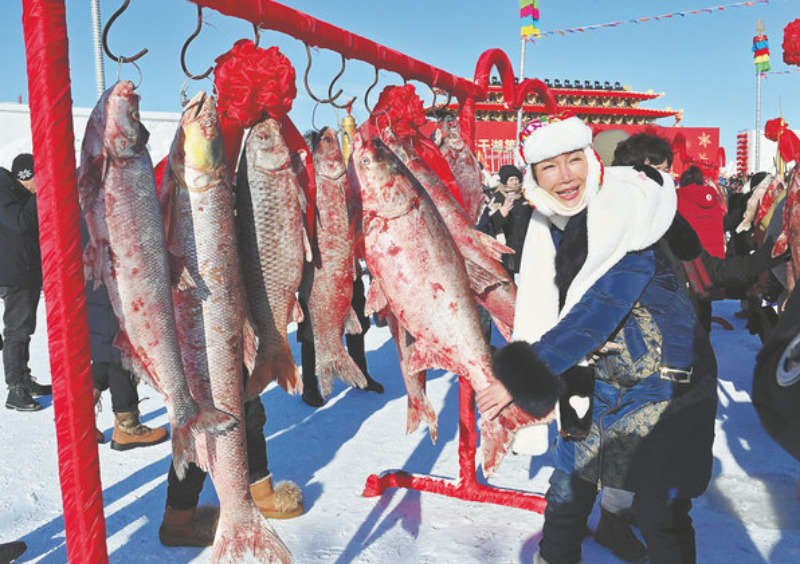Winter brings ice fishing to China's northeast

CHANGCHUN/HARBIN — A school of large fish thrashed about in a mile-long fish seine (a type of fishing net which hangs vertically in the water with floats at the top and weights at the bottom), hauled from the frozen Chagan Lake in Northeast China, as cheering crowds watched.
This spectacle was part of the millennium-old tradition of ice fishing, which has gained modern popularity as part of the country's booming winter tourism sector.
Shamilev Raschid, an international student from Germany, was among the onlookers at the fishing event in Jilin province. He also had the chance to try his hand at the ancient craft, learning how to haul the net through ice holes.
Raschid, who was part of a group of international students from Jilin University, says he finds ice fishing and the harmony between people and nature in the province impressive.
The tradition has emerged as the latest winter attraction in Jilin and neighboring Heilongjiang province, with the two-month season expected to last until mid-February.
In addition to the excitement, fresh fish soup is a visitor favorite. "Northeastern Chinese cuisine is full of flavor, and I'm impressed by the warm hospitality," says Allahverdiyeva Nazrin, an Azerbaijani student.
Ice fishing at Chagan Lake dates back to the Liao Dynasty (916-1125) and was recognized as a national intangible cultural heritage in 2008.The recent surge in tourism has breathed new life into the ancient practice.
Since the first seasonal haul on Dec 18, 2024, fishermen have landed several "red nets" — single catches exceeding 50,000 kilograms — which not only sparked cheers from spectators but also attracted millions of viewers through livestreaming.
During last year's snow season, Chagan Lake had 1.4 million visits, a remarkable year-on-year increase of 229.9 percent, generating record-breaking tourism revenue of 1.25 billion yuan ($173.87 million).
In December, China relaxed its visa-free transit policy, extending the permitted stay for eligible foreign travelers from 72 or 144 hours to 240 hours, and this is expected to attract more international tourists to the ice fishing season.
The visa-free transit policy allows international visitors to explore beyond famous sites and experience new cultures, Raschid says, adding that his friends and family plan to join him in Northeast China for winter tourism.
At Lianhuan Lake in the Mongolian autonomous county of Dorbod, Heilongjiang, a crowd cheered as a plentiful catch was hauled in during the annual ice fishing event.
The first haul yielded 175,000 kg of fish, which were sold at auction. Locally, the first winter catch is considered a symbol of good fortune.
During the ice fishing season, tourists can enjoy freshly prepared authentic dishes to the soothing sound of horsehead fiddles and traditional dances, while enjoying the fishing and hunting culture.
The ice fishing season on Lianhuan Lake, which runs until Feb 14, has transformed the remote lake into a hub, drawing crowds of anglers and tourists to its icy shores. Local authorities expect to welcome 200,000 visitors and generate 200 million yuan in revenue this season.
China has plans to make its winter economy a new growth sector worth 1.2 trillion yuan by 2027 and 1.5 trillion yuan by 2030, according to guidelines issued by the General Office of the State Council in November.
Heilongjiang has unleashed the potential of traditional ice fishing to boost the local fishery industry by expanding its industrial chain.
The province boasts over 6.5 million mu (about 433,333 hectares) of aquaculture ventures raising 100 fish species. Several cities have successfully integrated the development of aquaculture with tourism.
Huso dauricus, a large predatory sturgeon that was once a critically endangered species listed on the International Union for Conservation of Nature Red List of Threatened Species, has been bred and farmed artificially in lakes here.
"Huso dauricus has become a signature specialty of Tongjiang. We plan to develop the entire chain, from gourmet products and cosmetics to health supplements," says Wang Lin, mayor of Tongjiang city.
Lyu Hang, deputy mayor of Daqing city, says that a partnership has been formed with the Heilongjiang River Fisheries Research Institute to set breeding guidelines and artificial breeding regulations.
Heilongjiang produced 643,000 metric tons of fish in the first three quarters of 2024, a 5 percent increase on the previous year, with the value of its fisheries rising to 13.17 billion yuan, a 5.8 percent year-on-year growth, according to the provincial agriculture and rural affairs department.